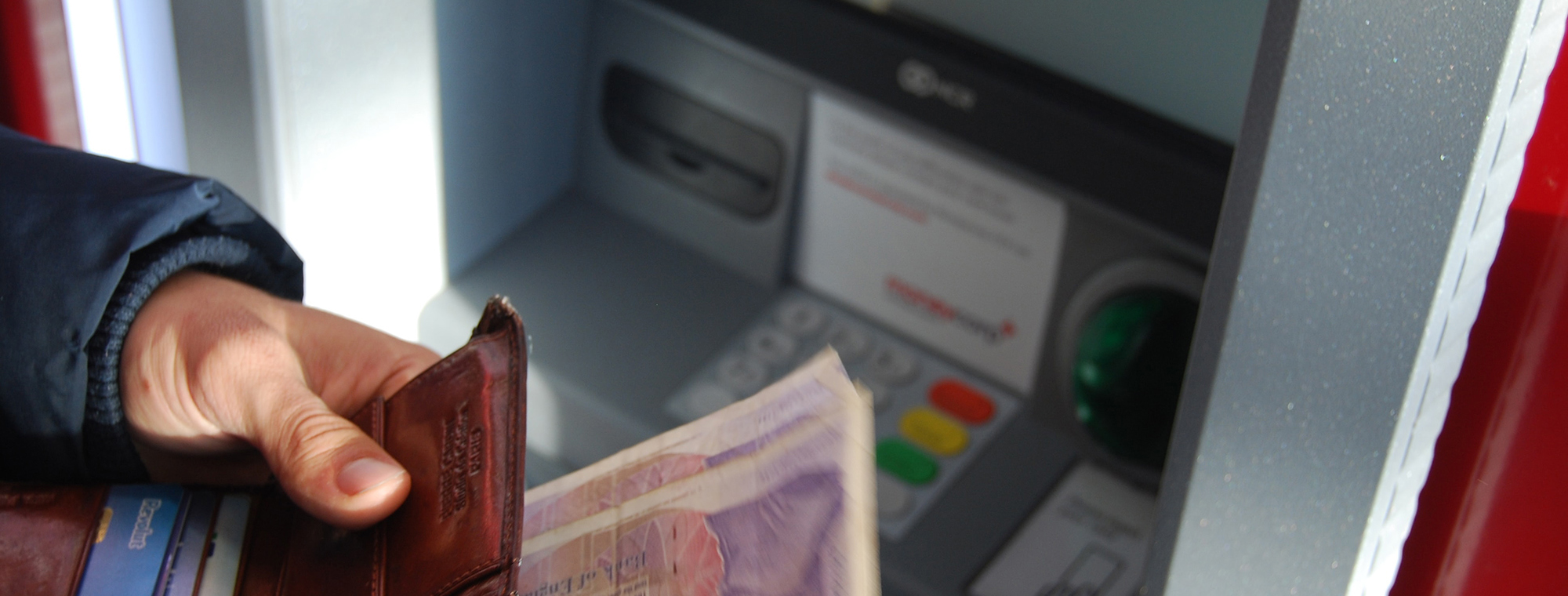Essential Tips for Using ATMs and Debit Cards in Foreign Countries
Setting a PIN, Fees, and Best Practices

Around the world, people understand the importance of cash-on-the-go and a secured purchase. When traveling abroad, an ATM can be a bit less direct and come with a few more fees than the cards you use at home. As with most international travel components, your best plan is to research. Let’s take a look at what it means to use ATMs abroad and also explore the best cards and options to help you get the most for your travel dollar.
Understand Exchange Rates
A dollar in the US is not a dollar in the UK. The value of currency from country to country will change based on various factors, including interest rates, inflation, current political stability, and the debt load of the country to which you’re exchanging. You should note that exchange rates are fluid and often change day to day. It’s not a bad idea to install an app on your smartphone before your trip to help you track exchange rates in the countries you plan to visit.
The good news about exchange rates is that you’re almost always guaranteed to get the most favorable exchange rate possible by using your debit card at an ATM, as opposed to changing literal currency at a conversion retailer. This is partly due to the fact that bank tellers or conversion counters can often add up to an additional 2% to the transaction, making your dollar worth less.
Having a basic understanding of the current exchange rate between countries prior to pulling funds from your ATM accounts will help you better compare “apples to apples” on how much money you really need and how much you’re really pulling out of your account.
Use a Debit Card, NOT a Credit Card
We recommend that you arm yourself with a debit card that draws funds from your checking account. Using your credit card can be prohibitively expensive at cash machines. Ensure that the bulk of your balance is in the primary account. Some foreign ATMs will only allow you to access the primary account for withdrawals instead of checking and savings accounts. Be prepared by having the bulk of your funds in the main account so that you don’t wind up without access to the cash you need.
IMPORTANT: Set a PIN Before You Travel to Avoid Debit Card Issues Abroad
Setting a PIN before you travel is essential to ensure that your debit card remains both functional and secure throughout your journey.
HOW TO SET a Debit Card PIN for International Travel
Ensure that your PIN code is no more than four characters long, as most European ATMs won’t accept longer pin codes. If your code exceeds four characters, talk to your bank about changing it at least two weeks before your trip. As well, often with European ATMs, you'll find that the pin code pads are solely numeric. If your pin is based on letters, you’ll want to convert that to numerals before your trip.
Having a PIN allows you to access local currency through ATMs, which is often more convenient and cost-effective than relying on currency exchange services or carrying large amounts of cash. Many international ATMs and point-of-sale systems require a PIN for transactions, so having one ensures you can use your card seamlessly abroad.
Additionally, a PIN adds an important layer of protection, making it more difficult for unauthorized individuals to access your funds if your card is lost or stolen.
This not only provides you with peace of mind but also the financial flexibility to handle unexpected situations, such as emergency expenses, in places where other forms of payment may not be accepted.
5 Top Reasons to Set Debit Card PINs Before Travel
-
Avoiding Card Issues Abroad: Some financial institutions and banks have made international travel easier by recognizing the first transaction in a foreign country as valid when you use your PIN. To ensure smooth access to your funds, contact your bank to confirm if using your PIN will override any potential fraud alerts or prevent your account from being frozen while traveling.
-
Access to Local Currency: With a PIN, you can withdraw local currency from ATMs abroad, which can be more convenient and cost-effective than using currency exchange services.
-
Security: A PIN adds an extra layer of protection, helping to secure your account if your card is lost or stolen. Without a PIN, anyone who finds your card may have an easier time accessing your funds.
-
Card Compatibility: Many international ATMs require a PIN to authorize withdrawals. Without a set PIN, you may find it challenging to access cash or complete transactions in other countries.
-
Emergency Funds: Having a PIN allows you to access cash in case of emergencies when other payment methods may not be accepted.
By taking the time to set up a PIN before your trip, you safeguard your finances, ensure your card remains functional and secure, and enhance your overall travel experience.
International Debit Card ATM Withdrawal Fees
When withdrawing cash abroad, you can typically expect a flat fee of $2 to $5 per transaction, along with an additional foreign transaction fee, usually between 1% and 3% of the amount. Some ATMs might also charge their own fees, which can vary depending on the location. Furthermore, choosing to use dynamic currency conversion (DCC) often results in higher costs, as the conversion rates are less favorable. Typically, the best bet is to make fewer withdrawals in larger amounts to try and cap the number of fees you are charged.
What is Dynamic Currency Conversion (DCC)?
Dynamic Currency Conversion (DCC) is a service offered by some international ATMs and point-of-sale (POS) terminals that allows travelers to choose between paying in their home currency (e.g., USD) or the local currency when making a withdrawal or purchase abroad. The idea behind DCC is to provide convenience by showing the amount in a familiar currency; however, it often comes with additional hidden fees and poor exchange rates.
When you choose to pay in your home currency through DCC, the ATM or merchant typically applies a markup on the conversion rate, which can make the transaction significantly more expensive than if you had paid in the local currency. The best practice is to always opt for payment in the local currency, allowing your own bank or credit card company to handle the conversion, as they generally offer more competitive rates.
To minimize these charges, consider using banks that offer reimbursement for international ATM fees or those that don’t charge for using out-of-network ATMs abroad, like certain accounts from Charles Schwab or Capital One. Alternatively, financial services like Wise or Revolut provide accounts with a limited number of free ATM withdrawals each month, which can help reduce costs while traveling.
Be sure to check with your bank before heading out on your trip to see the fees. These fees are often changed without warning and can vary greatly.
Plan Ahead and Keeping Your PIN Safe
Plan and, again, try to make only one or two larger withdrawals instead of making numerous little ones to limit these transaction fees. Memorize your four-digit PIN code for your debit card, but never write it down, and don't carry it with you. You can always tell a safe person back home and, worst-case scenario, give them a call in a pinch.
How to Find an ATM When Traveling
Your Travel Director or hotel concierge can help you find an ATM near your hotel or in the area. Another option is to seek out brands offered at home and abroad. ATM cards linked to the PLUS, Cirrus, or Maestro networks are often your best bet. With millions of ATMs worldwide, you’ll likely find one that accepts your card anywhere you travel. Each of these networks offers an online ATM locator service to plan to ensure that an ATM will be available in the locations you plan to travel to.
In addition, the back of your card will likely also have icons of other networks that will accept your card. ATMs will almost always identify the icons of cards they accept, so it becomes a simple matter of matching to see if your card is accepted at a particular ATM.
Best Debit Cards with No or Low Foreign Transaction Fees
Not all cards are created equally when it comes to international travel. If you play your debit cards right, you could get lucky and save hundreds on fees. For example, several banks are reputed for not charging foreign transaction fees for international usage.
| Charles Schwab | No Foreign Transaction Fees |
| Capital One | No Foreign Transaction Fees |
| Citizens Bank | 2% Foreign Transaction Fee |
Popular Credit Cards for Travelers
In addition to your debit card, many ATMs will be able to read a credit card and issue a cash advance. Just as with debit cards, you’ll want to do a bit of research into what your current credit card offers in international ATM access and fees and if there may be a better option for you. Many internet comparison sites rank the best cards for international travel. Top contenders are regularly listed as:
- Capital One Venture Rewards card
- Chase Sapphire Preferred card
- Discover It card
- Airline Rewards cards
Alternatives to Using an ATM
In addition to your bank ATM card, it is advised to carry at least one form of backup currency while traveling. Popular options include credit cards or pre-exchanged cash.
Are travelers’ checks a good idea?
These days, not really. The fees add up, and you need to take time out of your vacation to wait in line at a bank to cash them. Once again, using an ATM is a better choice.
Should You Exchange Money Before You Leave?
Some recommend buying a couple of hundred dollars worth of foreign currency from your bank before you leave. That way, you’ll have enough cash for incidental expenses if your credit or debit card fails to work.









